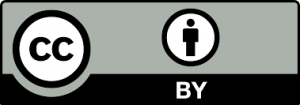7 Creative Commons Quick Start Guide
An important element of open educational resources is that they are openly licensed, but what does that mean?
An open license lets you retain ownership of your work, while allowing others to use, share, and remix it, without requesting your permission. For most open licenses, all that is required of the users is to attribute you for your work.
In this module, we’ll be introducing you to Creative Commons Licensing, which is the type of open licensing that you’re most likely to encounter. We’ll be discussing licensing and attribution in more detail in a future module; these are just the basics to get you started!
Creative Commons license elements
The Creative Commons license is an indication that only some rights are reserved. It’s basically a sign from the creator saying, “Go forth! Use this material for your own purposes! But please respect the ways which I have asked you to use it.”
So how does the creator indicate the conditions of reuse and modification? They can select one or more of the four key elements, or restrictions, listed below:
| Symbol | Word | License Acronym | Explanation |
|---|---|---|---|
  |
Attribution | BY | Attribution (BY): You must give appropriate credit, provide a link to the license, and indicate if changes were made. You may do so in any reasonable manner, but not in any way that suggests the licensor endorses you or your use. |
  |
Share Alike | SA | Share Alike (SA): If you remix, transform, or build upon the material, you must distribute your contributions under the same license as the original. |
  |
Non Commercial | NC | Non-commercial (NC): The material cannot be used for commercial purposes. |
  |
No Derivatives | ND | No Derivative Works (ND): If you remix, transform, or build upon the material, you may not distribute the modified material.
Note: Works licensed with the ND restriction are not considered to be true OERs. |
Creative Commons license types
There are six possible licenses that can be derived from combining the four license elements described above. The public domain license does not include any of the CC elements, but has been included for comparison.
Note: Every Creative Commons (CC) license except the Public Domain designation requires users to give attribution to the creator of the work.
Note: Since the “Share Alike” element specifically applies to works that have been remixed or transformed, it is incompatible with the “No Derivatives” element and therefore SA and ND cannot be combined under one license.
Important reminders
- You can only apply Creative Commons to works for which you are the copyright holder. You can’t give permission for people to use intellectual property that isn’t yours!
- All creative commons licenses are irrevocable. This means that once you apply a CC license to a work, that license applies to the work until the copyright on the work expires. If you are reusing a work, this means that you can be confident that the creator won’t -and can’t!- arbitrarily pull back the rights granted under the CC license.
- You can always request additional permissions that are not offered in the open license by contacting the creator.
- You can ask a librarian for advice or assistance!

